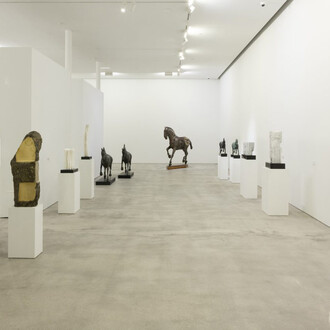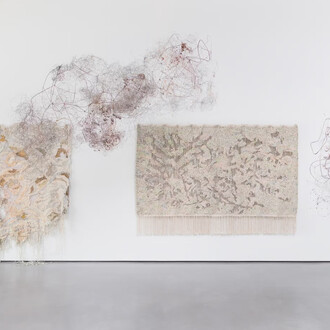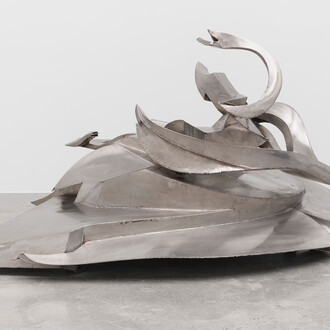Emerson Dorsch Gallery is pleased to announce Fountainhead Biennial II: Last Days of a House, the second edition in a series of exhibitions initiated by the gallery in 2021. Curated by Omar López-Chahoud, the exhibition will open Thursday July 27, 2023 and will be on view through September 30, 2023.
For the Fountainhead Biennial series, the gallery invites a guest curator to select from Fountainhead Residency alumni around a theme. López-Chahoud selected artworks with an austere, conceptual style, whose messages are rarely direct. Sometimes the only way truth-telling can land is by telling it obliquely, in code, or behind a veil. Sometimes, absorbing the bind you are in becomes part of the work and part of the critique.
During the process, López-Chahoud recalled the ethos evoked in “Últimos días de una casa,” a long form poem by Cuban author Dulce María Loynaz, who was born in 1902. Published in 1958, the poem is narrated from the perspective of the house. This was one of the last poems Loynaz published before she stopped writing poetry entirely. The Cuban Revolution was a year later, and it’s possible that Loynaz was detained. She never spoke of it, but we know that she chose to stop making her art and that she chose to stay in Cuba, in her childhood home, and that she chose silence as her resistance.
Loynaz remained committed to poetry built mostly with timeless or time-defiant elements, like a house, blood, souls, a rose, birds, a stone, marble, the sea, wind, her garden. She made a decision to remain with her house. It’s possible that the poetry she had written was part of her conviction. In her poetry she seems to believe utterly that forward movement is impossible, that each movement is fated to be undone. The ultimate commitment to her vision was to live it.
Loynaz’s poem then, and Loynaz’s story, became foils for the exhibition in a way that embraces sensitive associations. She imbues the house with human characteristics. This house recounts how it once was able to see the sea and misses its presence. Damage to its walls and floors are felt as cuts in flesh. Humanity’s ineffable and intangible characteristics, like souls, are contagion which infect the house.
With decidedly local and domestic imagery, Loynaz leaves her readers to wonder at her poems’ personal and political resonances, and there are many. Her poetry contains surreal and vivid imagery of loss and sorrow and a structural motif that repeats erasure or negation, like waves washing away markings in the sand. It feels natural to meditate on Loynaz’s house and her poem as if they are porous memories, open not only to her context, but also to the proximity of her imagery to works in this exhibition.
A house is a container. A vessel in many ways for the lives lived within it. It witnesses the many stages of lives, the patterns that build over time and can make human lives anyway, seem interchangeable. Generations come and go, are born and lost, and some come back. Christmas eves are dear memories. Neighborhoods change, and the sea, once within view, becomes a memory. Now when the sound of water intrudes, it is not waves crashing, but a roar of streaming water. Now the smell of sweet sea air fades and instead there is the smell of factories and brewing coffee.
Loynaz’s house hardly ever acknowledged action on the street, except as it pertained to her, as when the owner came to ready her for sale or demolition. Still, it’s easy to imagine the sounds she – the house – didn’t write down. The sounds in the street.
In Miami, middle class homes often feature a decorative wall with perforated cement. The wall often suggests a garden enclosure, like in the poem’s courtyard. They approximate the decorative perforations in stucco work in more ornate and luxurious settings, like the Alhambra in Spain, but the memory of those delicate designs is so distant that what matters is that geometric patterns in the bricks are more interesting than the blocks without. Sunlight can shine through, casting shadows. We become conditioned to these compromises. Perforations sometimes covered entire windows, so that ladies could spy on the courtyard below without being seen. So it was with caning on windows in colonial Rio de Janeiro, the ones that faced the street. Mano Penalva’s Bang, Bang Ventana (2019) brings together designs from these windows and thresholds and manages to reference that architectural device that turns gawking into peeking. The geometric designs, three circles stacked vertically, echo speakers, and remind us that sound could always travel.
Loynaz’s art enacted the lack of forward movement, a sort of fatalism that Crack Rodriguez rails against. His video La Trinidad (2016) shows him pushing tied books down a highway with a jet stream of water until the water runs out. The act is dangerous – the traffic streams around him on both sides of this four lane highway – and also futile. He enacts futility to stoke awareness in the regular people who see him, who drive past him. In those moments of annoyance, it’s possible a driver might put the parts together. A water truck, to which the water hose is attached, follows him. A man sits on top of the truck’s water tank, waving a white flag. It’s a way to caution the drivers, and there’s no mistake it’s a flag of truce or surrender. But does he want surrender?
Futility and fatalism can set in when conditions, like new buildings, hem you in and block the view of the sea. “The world is already small without anyone understanding it,” Loynaz wrote. Sounds of water change from waves to water cannons, and the old ornaments at the doors can become relics of an old world unable to respond to the present. Parts of a house’s refusal, its inertia, decorate the terrain of streams of action.
In Beijing the Forbidden Palace remains aloof from daily life. Its doors are studded with brass protrusions, arranged in a grid. Cathy Hsiao takes this motif and wraps it around a speaker, set on a shelf, playing interviews with pro-democracy activists and artists of their experiences of the 2019-20 Hong Kong protests. Printed social media photographs show how military forces used water cannons and dye to control the crowd. As in the rooms in Loynaz’s house, in Hsiao’s Sound Sculpture (2 channel) (2021) thresholds lead to others in ways that are consistent with the meaning, material and trajectory of the action. She creates montages with the diverse elements in her practice in the gallery space and on her website. To access details that are liminal, like the sound coming from the speakers in the gallery space, one must navigate two thresholds of links, one to a blog with her stylized coverage of Hong Kong Protests, and the other to more recordings. The viewer navigates through containers, like Loynaz’s phrases or rooms.
A house can outlive its inhabitants, and sometimes, as in Havana, when one person dies, another moves in. There aren’t enough places to live on the island to leave a house empty. Shells of people multiply, and the house grows numb to the differences between them. Hector Jiménez’s Torcida series represent in relief snake skins that could have come from any snake. A snake is a snake. And yet. There is the art of describing them, or of describing how their lives blur into multiples.
Somehow this house, she does not blur into the others. She remains herself even as she is partitioned, as families move in that are not the ones she remembers. As holes pressed into her walls remain unrepaired. Gouges in the floor remain. These violations wound her as if her walls and floors are flesh.
Indeed, wounds can calcify and become integral. Fleshy bulges spill over binds in Patricia Ayres’s sculpture. What seems fleshy is an upholstery system coddling together scraps of panty hose in various flesh tones. The containers they form are stuffed, then bound and stuffed again. There’s tension between the soft folds and tight belts and straps, and the balance between stuffing and binding holds the form together. The wounds build up becoming part of the being, containing something inside that is bubbling up. Without the centrifugal forces, the structure would fall in on itself.
Loynaz’s verses contain rooms, phrases inside phrases. And where there are actions or declarations, they are undone. Still, there is a pulsing feeling, a stone thrown into the air to be caught again. It is not nothing.
The world is used to losing and winning,
and so am I when life wants it so;
but win or lose, what I have been,
is a stone tossed into the air,
and the very hand that threw it
cannot halt its flight,
and it must slice through the air alone until it falls.
What I have been is in the air…”A perder y a ganar hecho está el mundo,
y yo también cuando la vida quiera;
pero lo que yo he sido, gane o pierda,
es la piedra lanzada por el aire,
que la misma mano que la lanzó no alcanza a detenerla,
y sola ha de cortar el aire hasta que caiga.
Lo que yo he sido está en el aire…
Loynaz, like her poem, was enigmatic. Straightforward language and presence belie existential concerns that await an attentive observer. The poem’s vivid imagery of lives lived and lost, of the cost of time passing, of sorrow and even bitterness, are all laid on the house’s bones. The corporeal root of this poem is a repeated motif in the exhibition, as well as the ways art can exist with and as resistance.
Dulce María Loynaz’s biography is remarkable in that she was a celebrated Cuban poet who chose to stay in Cuba after the revolution. Before the revolution, her father, a wealthy and influential figure in Cuba’s fight for independence from Spain, sent the seventeen-year-old Loynaz’s poems to La Nación to be published. Theirs was a home filled with friends who were luminaries, writers and artists. After those first poems most of her published works which enjoyed widespread acclaim throughout the Spanish speaking world were published in Spain. Her poetry’s lack of overt politics in an environment that demanded it amounted to a resistance to revolutionary goals at home. Following the revolution she stayed in Cuba, in her ancestral home, a fading mansion, refusing to write poetry or publish. She stayed but stopped making her art. Her work was ignored in Cuba and even actively suppressed until she received the Cervantes Prize in 1992. Late in her life, her work enjoyed a renaissance, but her work remains obscure to English speaking readers.
In a time when dogmatism and forms of censorship are rising in the United States and around the world, “Últimos días de una casa” has become so important that the gallery commissioned Mary Ann Newman, Director of the Farragut Fund for Catalan Culture, USA to translate the poem into English. The fact that a translation could not be found was itself a form of silencing. The poem’s stanzas will thread through the exhibition as artwork descriptions float into this reading of the poem.
Featured artists: Andrés Aizicovich, Rodrigue Mouchez Armendariz, Patricia Ayres, Merav Kamel & Halil Balabin, Minia Biabiany, Miguel Braceli, Héctor Jiménez Castillo, Adama Delphine Fawundu, Cathy Hsiao, Karlo Andrei Ibarra, Manoela Medeiros, Irini Miga, Terrence Musekiwa, Mano Penalva, Umar Rashid, Crack Rodríguez, Máret Ánne Sara, Joaquín Segura, and Andrey Gûaîanã Zignnatto.
Emerson Dorsch Gallery would like to thank Omar López-Chahoud, The Fountainhead Residency, Kathryn Mikesell, Nicole Martinez, Francesca Nabors, Mary Ann Newman, Ana Clara Silva, Daniel Clapp, Rachel Llaveria-Powell, Juan Gonzalez, Blum & Poe, Matthew Brown, Hesse Flatow, Galería Tiro al Blanco, Nara Roesler, Catinca Tabacaru, Portas Vilaseca Galeria, and Pequod Co.
















